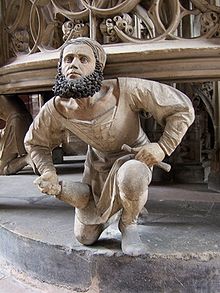Social status
Nuremberg sculptor Adam Kraft, self-portrait from St Lorenz Church, 1490s.
Worldwide, sculptors have usually been tradesmen whose work is unsigned. But in the Classical world, many Ancient Greek sculptors like Phidias began to receive individual recognition in Periclean Athens, and became famous and presumably wealthy. In the Middle Ages, artists like the 12th century Gislebertus sometimes signed their work, and were sought after by different cities, especially from the Trecento onwards in Italy, with figures like Arnolfo di Cambio, Nicola Pisano and his sonGiovanni. Many sculptors also practised in other arts, sometimes painting, like Andrea del Verrocchio, or architecture, like Giovanni Pisano, Michelangelo, or Jacopo Sansovino, and maintained large workshops.
From the High Renaissance artists like Michelangelo, Leone Leoni and Giambologna could become wealthy, and ennobled, and enter the circle of princes. Much decorative sculpture on buildings remained a trade, but sculptors producing individual pieces were recognised on a level with painters. From at least the 18th century, sculpture also attracted middle-class students, although it was slower to do so than painting. Equally women sculptors took longer to appear than women painters, and have generally been less prominent until the 20th century at least






0 comments:
Post a Comment
If U like this post then give me a comments about this post